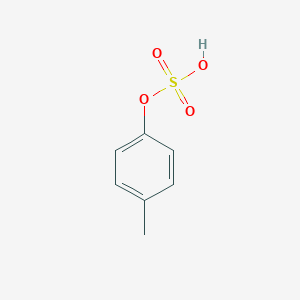| General Information of MET (ID: META00614) |
| Name |
p-Cresol sulfate
|
| Synonyms |
Click to Show/Hide Synonyms of This Metabolite
4-Cresol sulfate; 4-Cresol sulfuric acid; 4-Cresol sulphate; 4-Cresol sulphuric acid; Para-cresol sulfate; Para-cresol sulphate; Sulfate mono-p-tolyl ester; Sulfuric acid mono(p-tolyl) ester (8ci); Sulfuric acid mono-p-tolyl ester; Sulfuric acid, mono(4-methylphenyl) ester; Sulphate mono-p-tolyl ester; Sulphuric acid mono-p-tolyl ester; mono(4-Methylphenyl) sulfate; p-Cresol sulfuric acid; p-Cresol sulphate; p-Cresol sulphuric acid; p-Cresyl sulfate; p-Cresyl sulphate; p-Cresyl-sulfate; p-Cresyl-sulphate; p-Cresylsulfate; p-Cresylsulphate; p-Tolyl sulfate (6ci,7ci); p-Tolyl sulphate (6ci,7ci)
|
| Source |
Endogenous;Food;Toxins/Pollutant;Microbial
|
| Structure Type |
Arylsulfates (Click to Show/Hide the Complete Structure Type Hierarchy)
Organic acids and derivatives
Organic sulfuric acids and derivatives
Arylsulfates
|
| PubChem CID |
|
| HMDB ID |
|
| Formula |
C7H8O4S
|
| Structure |
<iframe style="width: 300px; height: 300px;" frameborder="0" src="https://embed.molview.org/v1/?mode=balls&cid=4615423"></iframe>
|
 |
|
3D MOL
|
2D MOL
|
|
Click to Show/Hide the Molecular/Functional Data (External Links/Property/Function) of This Metabolite
|
| ChEBI ID |
|
| FooDB ID |
|
| ChemSpider ID |
|
| Physicochemical Properties |
Molecular Weight |
188.2 |
Topological Polar Surface Area |
72 |
| XlogP |
1.3 |
Complexity |
220 |
| Heavy Atom Count |
12 |
Rotatable Bond Count |
2 |
| Hydrogen Bond Donor Count |
1 |
Hydrogen Bond Acceptor Count |
4 |
| Function |
p-Cresol sulfate is a microbial metabolite that is found in urine and likely derives from secondary metabolism of p-cresol. It appears to be elevated in the urine of individuals with progressive multiple sclerosis. p-Cresol sulfate is the major component of urinary MBPLM (myelin basic protein-like material). p-Cresol sulfate is a small protein-bound molecule that is poorly cleared with dialysis. It has been identified as a uremic toxin according to the European Uremic Toxin Working Group. Uremic toxins include other low-molecular-weight compounds such as indoxyl sulfate, 3-carboxy-4-methyl-5-propyl-2-furanpropionic acid, and asymmetric dimethylarginine. It has also been linked to cardiovascular disease and oxidative injury. Higher levels are associated with overgrowth of intestinal bacteria from Clostridia species, including C. difficile. p-Cresol is generated by the partial breakdown of tyrosine and phenylalanine by a wide range of intestinal obligate or facultative anaerobes, including the genera Bacteroides, Lactobacillus, Enterobacter, Bifidobacterium, and especially Clostridium.
|
|
Regulatory Network
|
|
|
|
|
|
|
|
|
 click to show the details of this protein
click to show the details of this protein
 click to show the details of experiment for validating this pair
click to show the details of experiment for validating this pair

